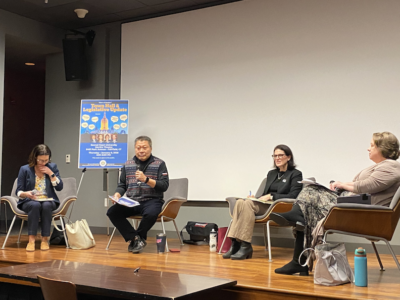
FAIRFIELD – Issues related to affordable housing, Medicaid reimbursement rates to healthcare facilities, mixed-use developments, and state spending are high on Fairfield and Easton residents’ minds for this year’s state legislative session.
“It will be a tough budget year,” state Sen. Tony Hwang of Fairfield and Easton told the audience at Sacred Heart University’s Martire Center on Thursday, Jan. 9. “This budget is going to be particular difficult. I say that because we are no longer going to have the federal supplemental ARPA (American Rescue Plan Act) money, which has been a real asset.”
Hwang, the ranking Republican member on the Senate Aging and Bonding committees, was joined by state Rep. Jennifer Leeper, chair of the House Education Committee; state Rep. Cristin McCarthy-Vahey, chair of the House Public Health Committee; and state Rep. Sarah Keitt, vice chair of the House Commerce Committee.
Affordable housing and Section 8-30(g)
“In Fairfield, we just applied for an 8-30(g) moratorium and now we have a 90-day open comment period,” Leeper said. “It’s a huge victory for our community. Developers can continue to put forward applications during these 90 days although I think we should put in an amendment to put in a freeze (on all affordable housing units) during this 90-day period.”
Under that affordable housing law, developers are allowed to bypass local zoning regulations and build affordable housing projects, potentially leading to concerns about the impact on existing neighborhood.
However, Section 8-30(g) allows municipalities to apply for a temporary moratorium on affordable housing developments. If granted by the state, the four-year moratorium allows a municipality to exempt itself from most affordable housing developments. A municipality may want to file for such an exemption from the affordable housing act to gain control over the pace and type of affordable housing development within their borders.
Under Section 8, states and local governments can determine eligibility for affordable housing. Commonly, households earning 80% of the Area Median Income (AMI) is the threshold for eligibility. In Connecticut, 80% of AMI is the threshold.
Every year, the U.S. Department of Housing & Urban Development (HUD) calculates and publishes the AMI for every geographic region in the country using data from the U.S. Census.
Currently, those thresholds are:
- Low-income households earn less than 80% of AMI
- Very low-income households earn less than 50% of AMI
- Extremely low-income households earn less than 30% of AMI.
In addition to affordable housing, the overall housing stock continues to be quite scarce.
“We will need to keep talking about housing,” McCarthy-Vahey said. “It is a crisis. Homelessness is on the rise.”
The longtime state representative described her experience at a recent open house.
“The Realtor who was showing the house for $1.2 million told me there were 45 single-family units on the market in Fairfield. And normally there, at this time, there are 600-plus. That in Easton there were only four single-family homes for sale. We just do not have supply.”
Medicaid reimbursement in CT
Healthcare facilities, including hospitals, nursing homes, and nonprofits aiding the poor are losing money due to a very low Medicaid reimbursement rate According to data from the state of Connecticut, in 2021, Medicaid paid 71.62% of nursing home costs in Connecticut and in 2022 hospitals were 62 cents on the dollar for treating Medicaid patients.
“I am really concerned that absolutely we have to increase our Medicaid reimbursement,” said Keitt, who sits on the Human Service and Public Health and Children committees. “I think we rank like 48th in the country. It not only affects those in the state that are on Medicaid, like children on Husky and our disabled adults and pregnant women, but it affects all of us because we lose providers.”
Edith Boyle, CEO of the community behavioral health services nonprofit Life Bridge Services in Bridgeport, believes state bureaucrats don’t understand the effect lower Medicaid rate reimbursement has on their services.
“In Bridgeport, our children and adults and families, and in Fairfield we serve a lot of seniors who have Medicare but have Medicaid as a secondary,” Boyle said. “But the one thing in common is 83% of the people that we serve are Medicaid-eligible.
“I want to say how disheartening it was to see the recent study by DSS (Department of Social Services) touting how cost-efficient our Medicaid program is. I really equate that to walking into a home of some of these (poor) families in Bridgeport and giving them accolades for being cost-efficient.”
She believes the lack of funds is causing her organization to lose talented therapists and counselors because Boyle can no longer afford to keep them. “We can’t compete with salary because it’s a joke what we pay compared to hospitals and private practices,” she said.
And then, the clincher for the services firm that serves about 2,000 patients per year.
After being in business for 175 years, Boyle announced she received their first going concern notice in their audit this year. “That means there is a concern that we may not be open in two years if things don’t change,” she said.
Hwang explained how he reached out to Gov. Ned Lamont about the problem.
“When I spoke to Gov. Lamont last year, I told him if you were going to tie healthcare cost containment to Medicaid rate based upon our benchmarking you are woefully off the mark because those rates are absolutely unsustainable,” the senator said. “You are punishing the patients themselves and also the providers – if they have a freedom of choice – and the quality of care.”






















